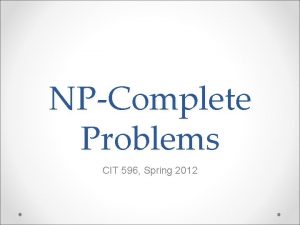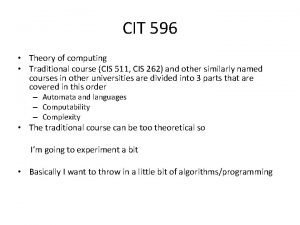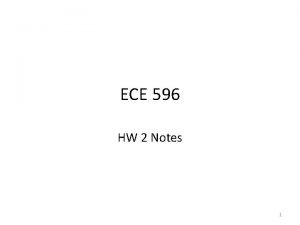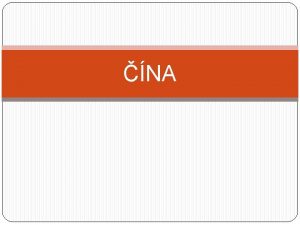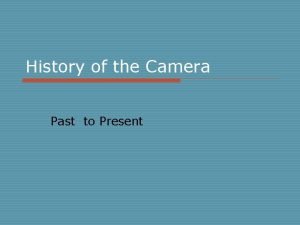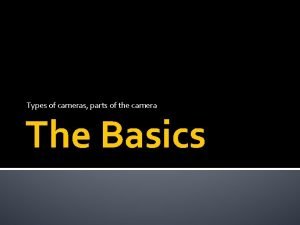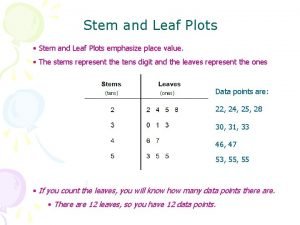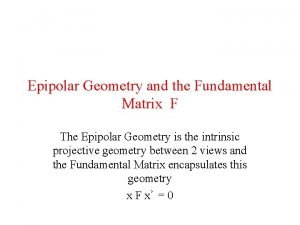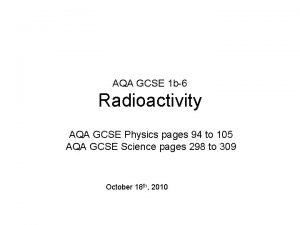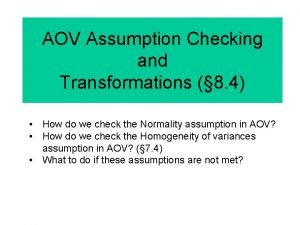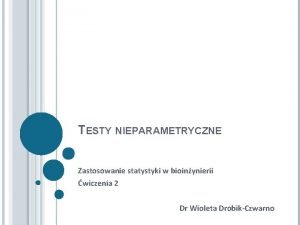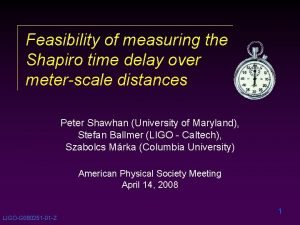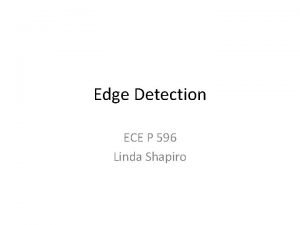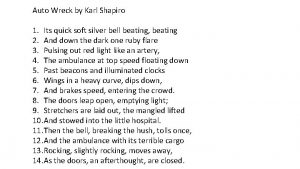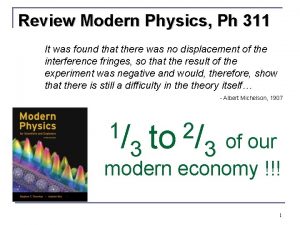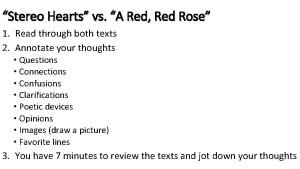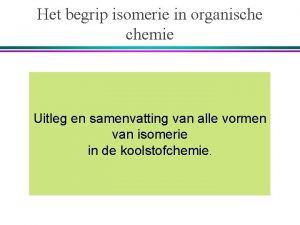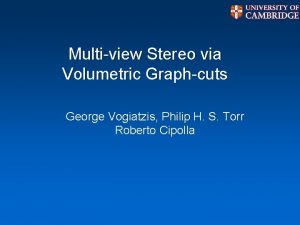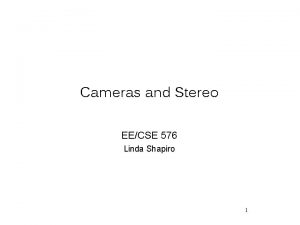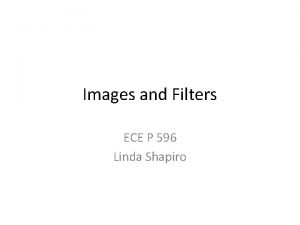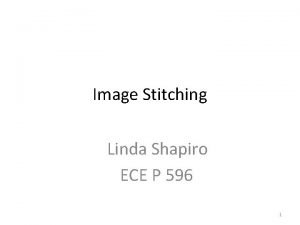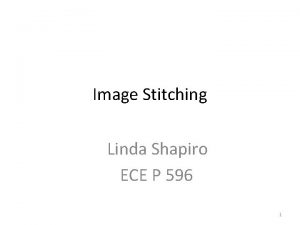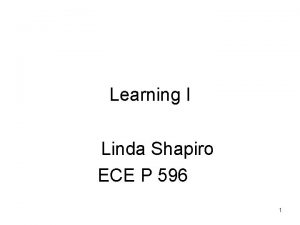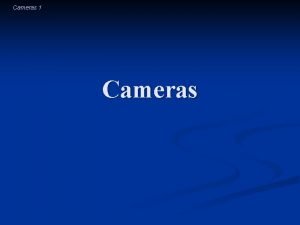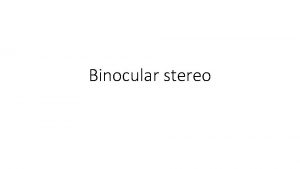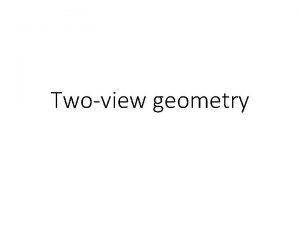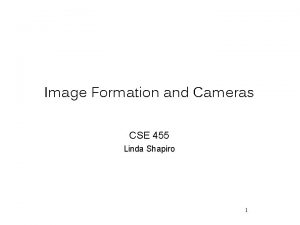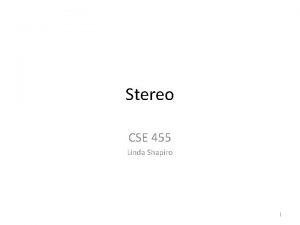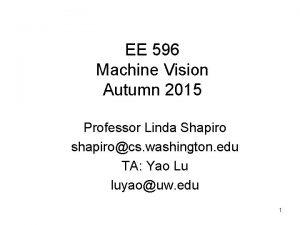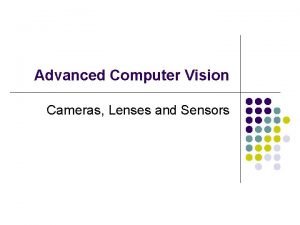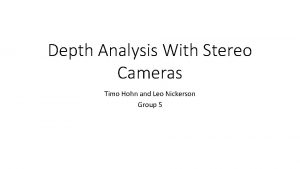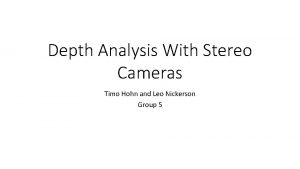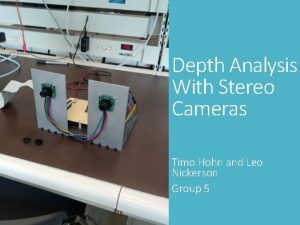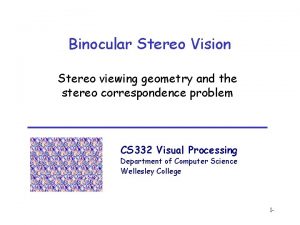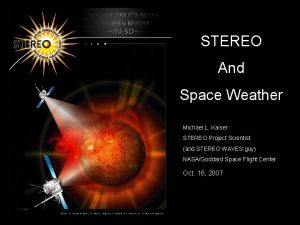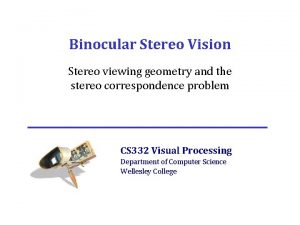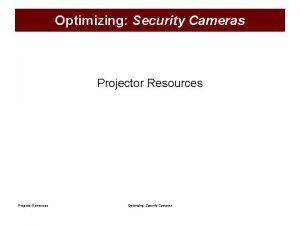Cameras and Stereo ECE P 596 Linda Shapiro








































- Slides: 40

Cameras and Stereo ECE P 596 Linda Shapiro 1

Camera parameters A camera is described by several parameters • • Translation T of the optical center from the origin of world coords Rotation R of the image plane focal length f, principal point (x’c, y’c), pixel size (sx, sy) blue parameters are called “extrinsics, ” red are “intrinsics” Projection equation • • The projection matrix models the cumulative effect of all parameters Useful to decompose into a series of operations identity matrix [tx, ty, tz]T intrinsics projection rotation translation • The definitions of these parameters are not completely standardized 2 – especially intrinsics—varies from one book to another

Where does all this lead? • We need it to understand stereo • And 3 D reconstruction • It also leads into camera calibration, which is usually done in factory settings to solve for the camera parameters before performing an industrial task. • The extrinsic parameters must be determined. • Some of the intrinsic are given, some are solved for, some are improved. 3

Camera Calibration The idea is to snap images at different depths and get a lot of 2 D-3 D point correspondences. x 1, y 1, z 1, u 1, v 1 x 2, y 2, z 1, u 2, v 2. . xn, yn, zn, un, vn Then solve a system of equations to get camera parameters. 4

Stereo 5

6

Amount of horizontal movement is … …inversely proportional to the distance from the camera 7

Depth from Stereo • Goal: recover depth by finding image coordinate x’ that corresponds to x X X z x x x' x’ f C f Baseline B C’ 8

Depth from disparity X z x x’ f O f Baseline B O’ Disparity is inversely proportional to depth. 9

Depth from Stereo • Goal: recover depth by finding image coordinate x’ that corresponds to x • Sub-Problems 1. Calibration: How do we recover the relation of the cameras (if not already known)? 2. Correspondence: How do we search for the matching point x’? X x x' 10

Correspondence Problem x ? • We have two images taken from cameras with different intrinsic and extrinsic parameters • How do we match a point in the first image to a point in the second? How can we constrain our search? 11

Key idea: Epipolar constraint X X X x x’ x’ x’ Potential matches for x have to lie on the corresponding line l’. Potential matches for x’ have to lie on the corresponding line l. 12

Epipolar geometry: notation X x x’ • Baseline – line connecting the two camera centers • Epipoles = intersections of baseline with image planes = projections of the other camera center • Epipolar Plane – plane containing baseline (1 D family) 13

Epipolar geometry: notation X x x’ • Baseline – line connecting the two camera centers • Epipoles = intersections of baseline with image planes = projections of the other camera center • Epipolar Plane – plane containing baseline (1 D family) • Epipolar Lines - intersections of epipolar plane with image planes (always come in corresponding pairs) 14

Example: Converging cameras 15

Example: Motion parallel to image plane 16

Epipolar constraint X x x’ • If we observe a point x in one image, where can the corresponding point x’ be in the other image? 17

Epipolar constraint X X X x x’ x’ x’ • Potential matches for x have to lie on the corresponding epipolar line l’. • Potential matches for x’ have to lie on the corresponding epipolar line l. 18

Epipolar constraint example 19

Epipolar constraint: Calibrated case X x x’ • Assume that the intrinsic and extrinsic parameters of the cameras are known • We can multiply the projection matrix of each camera (and the image points) by the inverse of the calibration matrix to get normalized image coordinates • We can also set the global coordinate system to the coordinate system of the first camera. Then the projection matrices of the two cameras can be written as [I | 0] and [R | t] 20

Simplified Matrices for the 2 Cameras = (R | T) 21

Epipolar constraint: Calibrated case X = (x, 1)T x x’ = Rx+t t R The vectors Rx, t, and x’ are coplanar 22

Epipolar constraint: Calibrated case X x x’ Essential Matrix E (Longuet-Higgins, 1981) The vectors Rx, t, and x’ are coplanar 23

Epipolar constraint: Calibrated case X x • • • x’ E x is the epipolar line associated with x (l' = E x) ETx' is the epipolar line associated with x' (l = ETx') E e = 0 and ETe' = 0 E is singular (rank two) E has five degrees of freedom 24

Epipolar constraint: Uncalibrated case X x x’ Fundamental Matrix (Faugeras and Luong, 1992) 25

Comparison of estimation algorithms 8 -point Normalized 8 -point Nonlinear least squares Av. Dist. 1 2. 33 pixels 0. 92 pixel 0. 86 pixel Av. Dist. 2 2. 18 pixels 0. 85 pixel 0. 80 pixel 26

Basic stereo matching algorithm • If necessary, rectify the two stereo images to transform epipolar lines into scanlines • For each pixel x in the first image – Find corresponding epipolar scanline in the right image – Search the scanline and pick the best match x’ – Compute disparity x-x’ and set depth(x) = f. B/(x-x’) 27

Stereo image rectification 29

Stereo image rectification • Reproject image planes onto a common plane parallel to the line between camera centers • Pixel motion is horizontal after this transformation • Two homographies (3 x 3 transform), one for each input image reprojection Ø C. Loop and Z. Zhang. Computing Rectifying Homographies for Stereo Vision. IEEE Conf. Computer Vision and Pattern Recognition, 1999. 30

Example Unrectified Rectified 31

Left Right scanline Matching cost disparity • Slide a window along the right scanline and compare contents of that window with the reference window in the left image • Matching cost: SSD, SAD, or normalized correlation 32

Correspondence search Left Right scanline SSD 33

Correspondence search Left Right scanline Norm. corr 34

Failures of correspondence search Textureless surfaces Occlusions, repetition Non-Lambertian surfaces, specularities 35

Results with window search Data Window-based matching Ground truth 36

Priors and constraints • Uniqueness – For any point in one image, there should be at most one matching point in the other image • Ordering – Corresponding points should be in the same order in both views • Smoothness – We expect disparity values to change slowly (for the most part) 37

Real-time stereo Nomad robot searches for meteorites in Antartica http: //www. frc. ri. cmu. edu/projects/meteorobot/index. html • Used for robot navigation (and other tasks) – Several software-based real-time stereo 38

Stereo reconstruction pipeline • Steps – Calibrate cameras – Rectify images – Compute disparity – Estimate depth What will cause errors? • • • Camera calibration errors Poor image resolution Occlusions Violations of brightness constancy (specular reflections) Large motions Low-contrast image regions 39

Multi-view stereo ? 40

Using more than two images Multi-View Stereo for Community Photo Collections M. Goesele, N. Snavely, B. Curless, H. Hoppe, S. Seitz Proceedings of ICCV 2007, 41
 Cit 596
Cit 596 Cit596
Cit596 Hw 596
Hw 596 596
596 9 596 960
9 596 960 Cina superficie km2
Cina superficie km2 Cameras from the past
Cameras from the past Speed detection of moving vehicle using speed cameras
Speed detection of moving vehicle using speed cameras Part of camera
Part of camera Stem and leaf chart
Stem and leaf chart Jacobs cameras
Jacobs cameras Epipolar
Epipolar Gamma cameras bbc bitesize
Gamma cameras bbc bitesize David shapiro natick
David shapiro natick Sheree shapiro
Sheree shapiro Shapiro
Shapiro Wood lane medical centre
Wood lane medical centre Test shapiro wilka
Test shapiro wilka Test shapiro wilka
Test shapiro wilka Roy d. shapiro
Roy d. shapiro Ben shapiro muscles
Ben shapiro muscles Shapiro time delay
Shapiro time delay Edge shapiro
Edge shapiro Jeffrey h. shapiro
Jeffrey h. shapiro Jo shapiro peer support
Jo shapiro peer support Duke blue paint
Duke blue paint Auto wreck poem
Auto wreck poem Transverse conductivity
Transverse conductivity Shapiro experiment
Shapiro experiment Dan shapiro usc
Dan shapiro usc Shapiro wilk teszt
Shapiro wilk teszt Multinational financial management definition
Multinational financial management definition Multinational financial management shapiro
Multinational financial management shapiro Stereo hearts poem
Stereo hearts poem Tcp stereo
Tcp stereo Spiegelbeeld isomerie
Spiegelbeeld isomerie Functie isomeren
Functie isomeren Would you mind turning down the music
Would you mind turning down the music Know the lingo worksheet answers
Know the lingo worksheet answers Multiview stereo
Multiview stereo Would you mind turning your music down
Would you mind turning your music down
